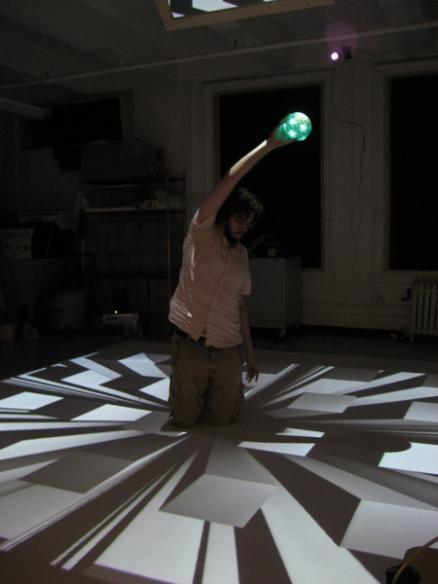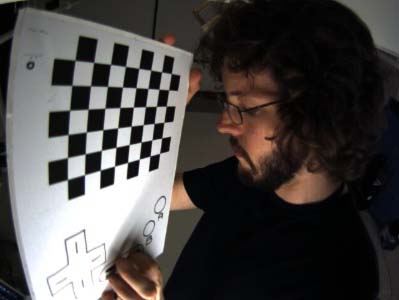projection
Sonic Slope and the Coordinate Dance
Here are a few more videos from last week's session with ASU. The first is a math game for two players to help students learn about slope through physical and audio interaction. The players can listen to the change in coordinates and then try to determine the right slope based on their positions in three-dimensional space.
There are some issues here with finding the right location for the balls that will prompt some work in the future. Knowing, for example, that you are "on" the right point in the Z-axis may require different kinds of audio cues. One idea we've had is a kind of sonic prompt that fades out when you've hit your mark, but gets louder and louder as you approach the boundary between two integers. This, we hope, will help people visualize where the number 2 and 3 are, rather than floating on the boundary between them and continually triggering the audio sample.
The next video is an improvised dance that the students can choreograph as they each try to reach their X and Y coordinates. This is a variation on the "Coordinate Game" that we had developed the day before. Hopefully, students will get an embodied sense of how the Cartesian system works as they move along in their algebra/geometry units.
It's not quite a game yet, but there's something really fun and compelling about making your own art work (a dance piece) that corresponds to your math assignment.
- Mike's blog
- Comments
- Read more



- 5498 reads
More Fake 3D
Here's more work on faking three dimensions on a flat plane.
 Disco 3D: Behold the three dimensions!
Disco 3D: Behold the three dimensions!
Again, this only works from the perspective of the ball, so one person needs to hold it fairly near their point of view to get the effect. And, from the brief demo we did at the workshop, sometimes people need a few minutes to adjust to the effect before they feel like they're navigating space.
At this point, it seems like more of a fun demo or a parlor trick. One really good suggestion we got recently, though, was that we could give participants a button, say on a Wiimore, that would allow them to assume the first person perspective if more than one person is navigating the space. That might help share the experience a bit better.
- Mike's blog
- Comments
- Read more



- 4883 reads
Faking 3D on a Flat Plane
We were experimenting with different ideas for how to represent the third dimension you have access to with the SMALLab installation. This is a trial using a camera viewpoint that tracks the position of the ball as you move through a space with it. It fools you into thinking that a 3d world is changing at your feet.
It's not a perfect solution. It only works for one person, and there are limits to how high you can pretend the Z-axis goes. Still, it's an interesting way of looking at the problem, and it might open more doors later on.
- Mike's blog
- Comments
- Read more



- 5547 reads
Who Likes Pancakes?
I like pancakes. Hey, everyone likes pancakes! Check out Kyle's awesome mod of his Pancake Express game for the SMALLab installation. It's a really great test of the kind of work we can do with new Render Engines. And it's a ton of fun.
- Mike's blog
- Comments



- 4646 reads
Engine Managin'
Kyle and I have made a lot of progress since the install went up for SMALLab. To date, we have the beginnings of Render Engine Managers for Python, Processing, and Flash (via XMLSocket).
The Python version, PyREM, can create engines and pass properties based on responses from SCREM. I still need to get it to destroy engines, as well as accept and display media library files, but it's moving along pretty well.
The ASU folks put together a really nice and flexible system. I'm really encouraged by how quickly we've gotten up to speed now. I'll post pics once more interesting work gets rolling.
- Mike's blog
- Comments
- Read more



- 4961 reads
A Good Week for the Arizonans
Couple of awesome updates. The most important is that Shawn and Kelly from ASU helped Kyle and me set up the SMALLab installation at Parsons. Very, very cool.
 Distortion: Me with a checkerboard as the SMALLab team tries to fix the distortion on the fisheye lenses.
Distortion: Me with a checkerboard as the SMALLab team tries to fix the distortion on the fisheye lenses.
Kyle and I got processing communicating with the system in about a half hour and made a couple of nice sketches with two balls tracking. Should be a good kick off for making lessons starting two weeks from now. Here's a YouTube video of that:
- Mike's blog
- Comments
- Read more



- 4844 reads
Distortion
- Comments



- 10929 reads
tags
Copyright Mike Edwards 2006-2009. All content available under the Creative Commons Attribution ShareAlike license, unless otherwise noted.




